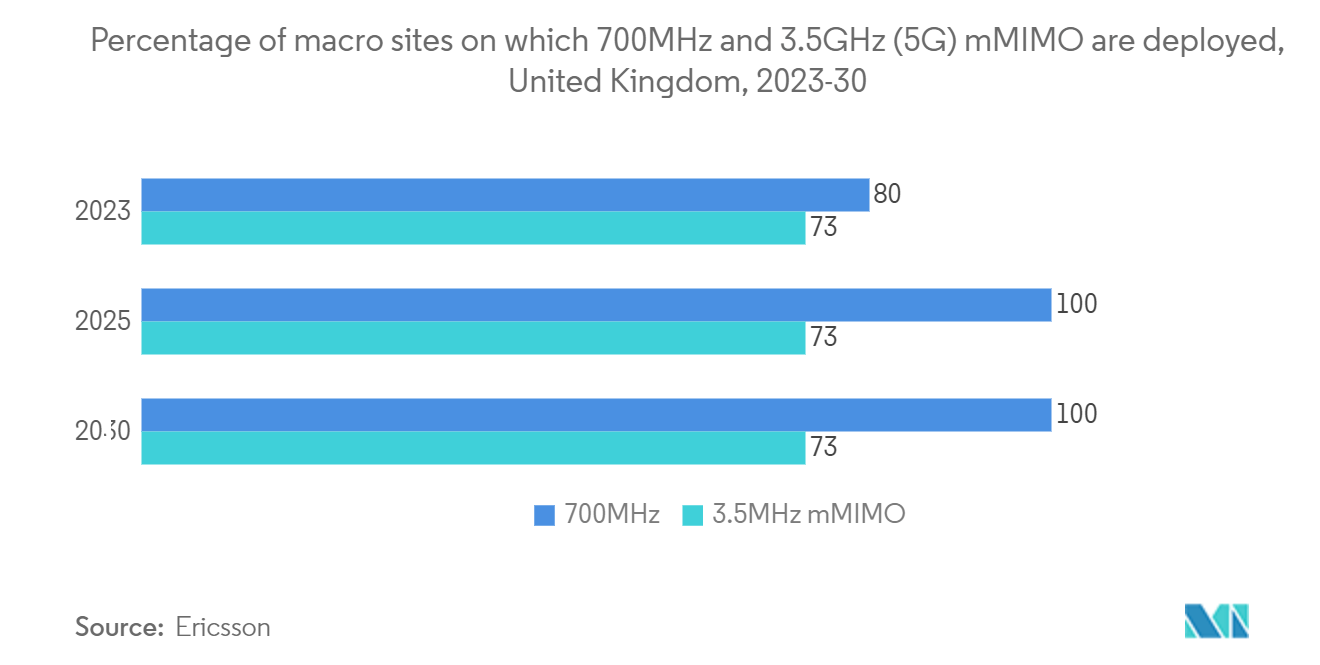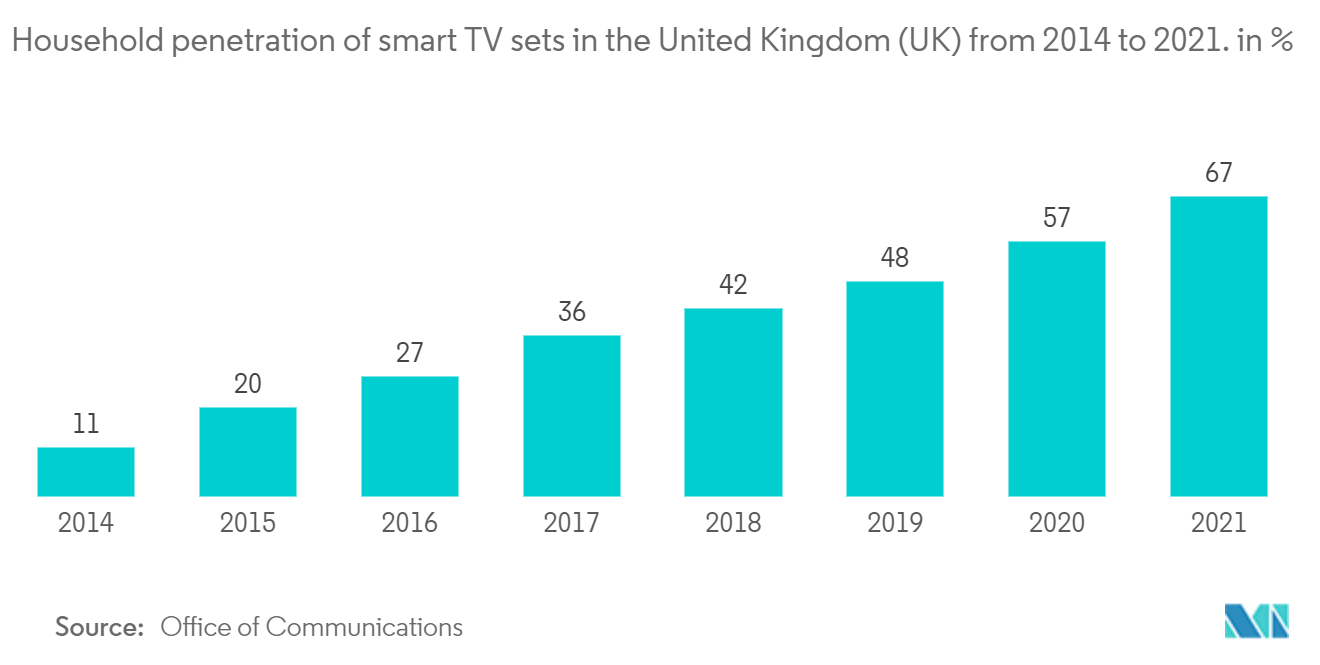Market Trends of UK Telecom Industry
This section covers the major market trends shaping the UK Telecom Market according to our research experts:
5G Roll-Out in the United Kingdom to Drive the Market
- With the debut of the 5G network by EE in May 2019, the United Kingdom was one of the first markets to offer the technology internationally. Since then, the market has performed at a level with many other European markets in terms of 5G despite the United Kingdom operators increasing their 5G expenditure. As per the Connected Nations 2021 study from the Office of Communications, the United Kingdom's 5G network investment is rising, reaching GBP 330 million in 2020, up more than GBP 150 million (88%) from 2019.
- Hotspot installations in suburban regions and along major transportation routes supplement the high-capacity C-band spectrum, the primary technology supporting dense metropolitan areas. In 2020 and 2021, the number of mobile base stations offering 5G services quadrupled, rising from 3,000 locations to over 6,500 sites. According to the EU 5G Observatory's International Scoreboard, this would put the United Kingdom significantly behind South Korea, China, the European Union average, and even the United States, with over 10,000 people per 5G base station based on the country's population as of 2020.
- The mobile network operators in the United Kingdom already install and manage a portion of their radio access network (RAN) through network sharing agreements to cut costs and optimize network rollout. EE and Three UK have formed Mobile Broadband Network Limited (MBNL) as a 50/50 joint company to oversee the planning and management of their shared network. In 2019 O2 and Vodafone announced that they would share 5G-active hardware, such as radio antennae, to hasten the rollout of 5G and lower the cost. Vodafone gave Vantage Towers a 50% stake in the company in January 2021.
- All four carriers in the UK have been using mid-band spectrum for 5G since the first installations, which is regarded as a spectrum "sweet spot" that provides both quick speeds and extensive geographic coverage. Every operator increased their spectrum holdings in the 700 MHz and 3.6-3.8 GHz frequency bands in April 2021. The operator's 5G coverage already encompasses 300 towns and cities, and its 5G services are expected to be available to 50% of the United Kingdom's population by 2023. The government also said in December 2021 that it wanted to stop supporting 2G and 3G networks by 2033 to make room for 5G.
- In the United Kingdom, 5G is presently being implemented in a non-standalone (NSA) mode, which means it still depends on the 4G LTE core network. With 5G core networks and 5G RAN, it is anticipated that all operators will eventually upgrade to 5G standalone (SA), significantly as more 5G capabilities, like ultra-low latency communication (URLC) and virtual network functions, like network slicing, proliferate and open new use cases for the technology. The recent edge computing and 5G SA partnership between EE, the BBC, and Ericsson demonstrated the unique powers of these technologies. The transition to a cloud-based core and the introduction of 5G SA by 2023 may make it easier for EE to expand 5G coverage to 90% of the geographic area of the United Kingdom by 2028. Additionally, EE intends to market 5G SA in a way that appeals to consumers and "brings technology to people in a truly personal way."

Superior Cyber Security to Aid in Market Growth
- The technical environment in many businesses in the United Kingdom is evolving quickly because of IoT devices and sensors. The Internet of Things has numerous positive effects on people's lives, including improved quality of life and more business revenue. The cost of government IT may also be significantly reduced, which is advantageous to everybody. In the United Kingdom, the "Internet of Things" has developed because of the confluence of several technologies. First, as more gadgets connect to the internet, this technical development enhances steady connectivity. Second, telecommunications may now track communication remotely with IoT. Through its usefulness, IoT has led to a seamless process across several companies in the country, resulting in a rise in income.
- The Internet of Things (IoT) is a global network of interconnected gadgets and sensors. It is expected that the United Kingdom will become closer to a fully connected Britain in 2022 as 5G coverage expands and millions more gadgets start utilizing the internet of things. Businesses may link their devices to a centralized hub using a fixed-IP SIM card, which is ideal for remote monitoring and control. Thousands of companies in the country currently employ IoT, primarily in the manufacturing, transportation, and industrial sectors. Their procedures' ability to be linked to an online platform considerably increases efficiency and lowers operating expenses.
- To make the advantages of IoT more available to companies of all sizes and digital sophistication levels, Vodafone has developed a variety of IoT solutions. For instance, the Smart Hub enables logistics firms to follow freight or cars even in far-flung areas where regular services are impractical - with it, almost anywhere in the United Kingdom can get a WiFi-strength connection. This might be used by emergency services in rural regions to coordinate quick actions in even the most dangerous circumstances and communicate with other blue-light colleagues.
- Following consultation with various industry "stakeholders," the United kingdom's telecom regulator, Office of Communications, has determined four areas that it intends to focus on to encourage the growth of the Internet of Things. Spectrum availability, data privacy, network security and resilience, and network addressing is the regulator's top priorities for promoting IoT growth. According to the Office of Communications, the IoT may increase reliance on safe and dependable data networks and storage, so that's a prominent priority area for promoting growth. Given that the most recent communications protocol better enables numerous connections, together with IPv6.
- By establishing a regulatory framework that may encourage investment and innovation, the telecoms regulator, Office of Communications, hopes to guarantee that the United Kingdom takes the lead in developing the Internet of Things (IoT). According to the Office of Communications report, 360 million IoT-connected devices will be developed, and more than a billion daily data will be exchanged by 2022. Service providers may have to run and manage a considerable number of relatively low-powered connected devices, each needing access to spectrum, whether or not the much-hyped figure of 50 billion devices or more is reached within five years.
- Every environmental issue is becoming more and more well-known in the United Kingdom, leading to the development of Green IoT. It entailed utilizing technology that assists in developing a healthy IoT environment. As a result, it focuses on helping users across the country; gather, store, and access data through the available storage and facilities.

